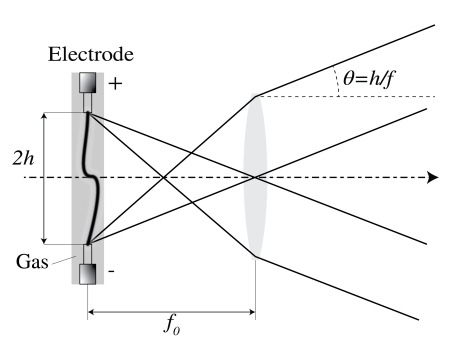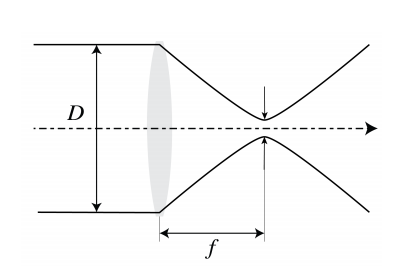7.1: Unique Properties of Lasers
( \newcommand{\kernel}{\mathrm{null}\,}\)
The broad applications of lasers are made possible by their unique properties which distinguishes them from all other light sources. We discuss these unique properties below.
7.1.1 High Monochromaticity; Narrow Spectral Width; High Temporal Coherence
These three prperties basically are the same. Saying that the laser has high monochromaticity or that it has a very narrow spectral width means that it emits a very narrow band of frequencies, A spectral lamp, like a gas discharge lamp based on Mercury vapor, can have a spectral width Δν=10GHz. Visible frequencies are around 2×1014 Hz, hence the spectral width of the lamp is roughly 0.02%. The line width measured in wavelengths satisfies Δλλ=Δνν,
By contrast, a laser can easily have a frequency band that is a factor of 100 smaller, i.e. less than 10MHz=107 Hz in the visible. For a wavelength of 550 nm this means that the linewidth is only 0.001 nm. As has been explained in Chapter 7 , the coherence time τc of the emitted light is the reciprocal of the frequency bandwidth: τc=1/Δν.
Light is emitted by atoms in bursts of harmonic (cosine) waves consisting of a great but finite number of periods. As will be explained in this chapter, due to the special configuration of the laser, the wave trains in laser light can be extremely long, corresponding to a very long coherence time.
7.1.2 Highly Collimated Beam
Consider a discharge lamp as shown in Figure 7.1.1. To collimate the light, the discharge lamp can be positioned in the focal plane of a lens. The spherical waves emitted by all point sources (atoms) in the lamp are collimated into plane waves whose direction depends on the position of the atoms in the source. The atoms at the edges of the source determine the overall divergence angle θ, which is given by θ=h/f,


7.1.3 Diffraction-Limited Focused Spot, High Spatial Coherence
If we add a second lens after the first lens in Figure 7.1.3 a spot is obtained in the focal plane of the second lens. This spot can be very small only when the light has been almost perfectly collimated by the first lens.
What is the smallest focal spot that one can achieve? If one focuses a perfectly collimated beam with a lens with very small aberrations and with numerical aperture NA, the lateral size of the focused spot is, according to Chapter 6 , diffraction-limited and given by diffraction-limited spot size =0.6fDλ=0.6λNA.
As has been explained in Chapter 5, a light wave has high spatial coherence if at any given time, its amplitude and phase in transverse points can be predicted. The spherical waves emitted by a point source have this property. But when there are many point sources (atoms) that each emit bursts of harmonic waves that start at random times, as is the case in a classical light source, the amplitude and phase of the total emitted field at any position in space cannot be predicted. The only way to make the light spatially coherent is by making the light source very small, but then there is hardly any light. As will be explained below, by the design of the laser, the emissions by the atoms of the amplifying medium in a laser are phase-correlated, which leads to a very high temporal and spatial coherence. The property of a small spot size with high intensity is essential for many applications, such as high resolution imaging, material processing with cutting, welding and drilling spots with very high power and in retina surgery, where a very small, high-intensity spot is applied to weld the retina without damaging the surrounding healthy tissue.

7.1.4 High Power
There are two types of lasers namely continuous wave (CW) lasers, which produce a continuous output, and pulsed lasers which emit a train of pulses. These pulses can be very short: from a nanosecond to even femtoseconds (10−15 s). A relatively low-power CW laser is the HeNe laser which emits roughly 1 mW at the wavelength 632 nm. Other lasers can emit up to a megawatt of continuous power. Pulsed lasers can emit enormous peak intensities (i.e. at the maximum of a pulse), ranging from 109 to 1015 Watt.
There are many applications of high-power lasers such as for cutting and welding materials. To obtain EUV light with sufficient high intensity for use in photolithography for manufacturing ICs, extremely powerful CO2 lasers are used to excite a plasma. Extremely high-power lasers are also applied to initiate fusion and in many nonlinear optics applications. Lasers with very short pulses are also used to study very fast phenomena with short decay times, and to realise faster clocks.
7.1.5 Wide Tuning Range
For a wide range of wavelengths, from the vacuum ultra-violet (VUV), the ultra-violet (UV), the visible, the infrared (IR), the mid-infrared (MIR) up into the far infrared (FIR), lasers are available. For some type of lasers, the tuning range can be quite broad. The gaps in the electromagnetic spectrum that are not directly addressed by laser emission can be covered by techniques such as higher harmonic generation and frequency differencing.

